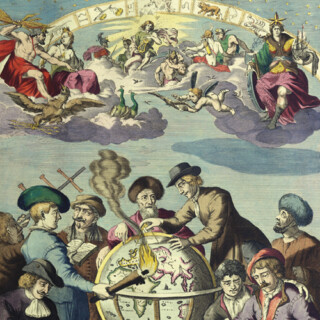-
×
 Yeakell and Gardner’s landmark map of Sussex
1 × £5,000
Yeakell and Gardner’s landmark map of Sussex
1 × £5,000
[Pocket Globe] West. Bazaar, Soho Square London.
London,
Soho,
[1808].
Globe, 12 hand-coloured engraved paper gores, clipped at 70 degrees latitude, with two polar calottes, over a papier mâché and plaster sphere, paste-over imprint to cartouche, varnished, housed in original black shagreen over paste-board clamshell case, with hooks and eyes, lined with two sets of 12 hand-coloured engraved celestial gores. Diameter: 70mm (2.75 inches).
Diameter: 70mm (2.75 inches).
22000
notes:
An extremely rare pocket globe that preserves a tangible link to a working woman in early-nineteenth century London.
The globe is the work of Nicholas Lane (fl1775-1783), whose business was particularly associated with pocket globes. First issued in 1779, the plates were updated in 1807 by Lane's son, Thomas, who took over the business after his father's death. Sold wholesale, often retailers would paste their own name and address over that of Lane in the cartouc...
The globe is the work of Nicholas Lane (fl1775-1783), whose business was particularly associated with pocket globes. First issued in 1779, the plates were updated in 1807 by Lane's son, Thomas, who took over the business after his father's death. Sold wholesale, often retailers would paste their own name and address over that of Lane in the cartouc...
bibliography:
Dekker, pp.393-394; Sumira, 35 and 45; Worms and Baynton-Williams, p.451.
provenance:







![LANE, [Thomas after Nicholas LANE] [Pocket Globe] West. Bazaar, Soho Square London.](https://i0.wp.com/crouchrarebooks.com/wp-content/uploads/2024/12/22000_1H-scaled.jpg?fit=2560%2C2294&ssl=1)
![LANE, [Thomas after Nicholas LANE] [Pocket Globe] West. Bazaar, Soho Square London.](https://i0.wp.com/crouchrarebooks.com/wp-content/uploads/2024/12/22000_3H-scaled.jpg?fit=2560%2C1571&ssl=1)
![LANE, [Thomas after Nicholas LANE] [Pocket Globe] West. Bazaar, Soho Square London.](https://i0.wp.com/crouchrarebooks.com/wp-content/uploads/2024/12/22000_5H-scaled.jpg?fit=2433%2C2560&ssl=1)
